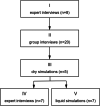Simulation-based development: shaping clinical procedures for extra-uterine life support technology
- PMID: 38042828
- PMCID: PMC10693037
- DOI: 10.1186/s41077-023-00267-y
Simulation-based development: shaping clinical procedures for extra-uterine life support technology
Abstract
Background: Research into Artificial Placenta and Artificial Womb (APAW) technology for extremely premature infants (born < 28 weeks of gestation) is currently being conducted in animal studies and shows promising results. Because of the unprecedented nature of a potential treatment and the high-risk and low incidence of occurrence, translation to the human condition is a complex task. Consequently, the obstetric procedure, the act of transferring the infant from the pregnant woman to the APAW system, has not yet been established for human patients. The use of simulation-based user-centered development allows for a safe environment in which protocols and devices can be conceptualized and tested. Our aim is to use participatory design principles in a simulation context, to gain and integrate the user perspectives in the early design phase of a protocol for this novel procedure.
Methods: Simulation protocols and prototypes were developed using an iterative participatory design approach; usability testing, including general and task-specific feedback, was obtained from participants with clinical expertise from a range of disciplines. The procedure made use of fetal and maternal manikins and included animations and protocol task cards.
Results: Physical simulation with the active participation of clinicians led to the diffusion of tacit knowledge and an iteratively formed shared understanding of the requirements and values that needed to be implemented in the procedure. At each sequel, participant input was translated into simulation protocols and design adjustments.
Conclusion: This work demonstrates that simulation-based participatory design can aid in shaping the future of clinical procedure and product development and rehearsing future implementation with healthcare professionals.
Keywords: Artificial placenta; Artificial womb; Co-creation; Extra-uterine life support; Participatory design; Perinatal life support technology; Simulation-based development.
© 2023. The Author(s).
Conflict of interest statement
JSvH, MM, MBvdH-vdJ, FLMD, and SGO are coauthors on a patent entitled ‘Transfer Of A Preterm Baby From A Natural Womb’ (Patent no. WO2022066014). JSvH, MM, FLMD, and SGO are coauthors on a patent entitled ‘Transfer Of A Preterm Baby From A Natural Womb’ (Patent no. WO2023027584A1). The remaining authors have no competing interests to disclose.
Figures




References
-
- Partridge EA, Davey MG, Hornick MA, McGovern PE, Mejaddam AY, Vrecenak JD, Mesas-Burgos C, Olive A, Caskey RC, Weiland TR, Han J, Schupper AJ, Connelly JT, Dysart KC, Rychik J, Hedrick HL, Peranteau WH, Flake AW. An extra-uterine system to physiologically support the extreme premature lamb. Nat Commun. 2017;8:1–15. doi: 10.1038/ncomms15112. - DOI - PMC - PubMed
Grants and funding
LinkOut - more resources
Full Text Sources

